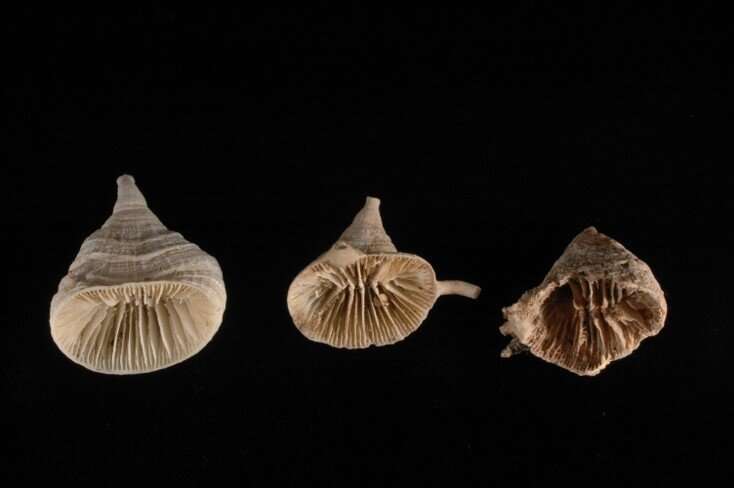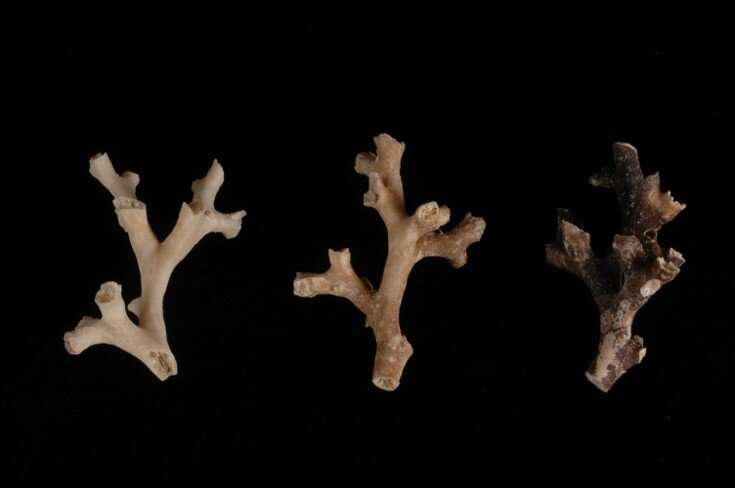Credit: Dann Blackwood, USGS
The fossilized remains of ancient deep-sea corals may act as time machines providing new insights into the effect the ocean has on rising CO2 levels, according to research carried out by the Universities of St Andrews, Bristol and Nanjing.
Rising CO2 levels helped end the last ice age, but the cause of this CO2 rise has puzzled scientists for decades. Using geochemical fingerprinting of fossil corals, an international team of scientists has found new evidence, published in Science Advances this week, that this CO2 rise was linked to extremely rapid changes in ocean circulation around Antarctica.
The team collected fossil remains of deep-sea corals that lived thousands of meters beneath the waves. By studying the radioactive decay of the tiny amounts of uranium found in these skeletons, they identified corals that grew at the end of the ice age around 15,000 years ago.
Further geochemical fingerprinting of these specimens—including measurements of radiocarbon—allowed the team to reconstruct changes in ocean circulation and compare them to changes in global climate at an unprecedented time resolution.
Professor Laura Robinson of the University of Bristol, who led the research team, said: "The data show that deep ocean circulation can change surprisingly rapidly, and that this can rapidly release CO2 to the atmosphere."
Dr. James Rae, of the School of Earth and Environmental Sciences at the University of St Andrews, added: "The corals act as a time machine, allowing us to see changes in ocean circulation that happened thousands of years ago. They show that the ocean round Antarctica can suddenly switch its circulation to deliver burps of CO2 to the atmosphere."
Credit: Dann Blackwood, USGS
Scientists have suspected that the Southern Ocean played an important role in ending the last ice age and the team's findings add weight to this idea.
Dr. Tao Li of Nanjing University, lead author of the new study, said: "There is no doubt that Southern Ocean processes must have played a critical role in these rapid climate shifts and the fossil corals provide the only possible way to examine Southern Ocean processes on these timescales."
In another study published in Nature Geoscience this week the same team ruled out recent speculation that the global increase in CO2 at the end of the ice age may have been related to release of geological carbon from deep sea sediments.
Andrea Burke, of the School of Earth and Environmental Sciences at the University of St Andrews, said: "There have been some suggestions that reservoirs of carbon deep in marine mud might bubble up and add CO2 to the ocean and the atmosphere, but we found no evidence of this in our coral samples".
Dr. Tianyu Chen of the Nanjing University, author of this study, said: "Our robust reconstructions of radiocarbon at intermediate depths yields powerful constraints on mixing between the deep and upper ocean, which is important for modeling changes in circulation and carbon cycle during the last ice age termination."
Dr. James Rae added: "Although the rise in CO2 at the end of the ice age was dramatic in geological terms, the recent rise in CO2 due to human activity is much bigger and faster. What the climate system will do in response is pretty scary."
More information: Tianyu Chen et al. Persistently well-ventilated intermediate-depth ocean through the last deglaciation, Nature Geoscience (2020). DOI: 10.1038/s41561-020-0638-6
Journal information: Science Advances , Nature Geoscience
Provided by University of St Andrews

























